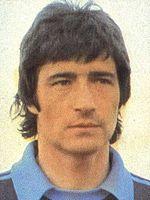Nasser Hejazi
Nasser Hejazi was born in Tehran, Tehran Province, Iran on December 14th, 1949 and is the Soccer Player. At the age of 61, Nasser Hejazi biography, profession, age, height, weight, eye color, hair color, build, measurements, education, career, dating/affair, family, news updates, and networth are available.
At 61 years old, Nasser Hejazi has this physical status:
Hejazi was the goalkeeper of the Taj Tehran and Iran during the 1970s. Hejazi first broke into the Taj side when he was only 18 years old and while a member of the now defunct Nader FC. He won the Asian Club Championship in 1970; he also won the Iranian league in 1971 as well as 1975 and was positioned second in 1974. Further on, he won the Hazfi Cup in 1977.
In summer 1977 he changed the club joining Shahbaz Tehran, trying to win the 1977–78 Takht Jamshid Cup with his famous National teammates Gholam Hossein Mazloumi, Nasrollah Abdollahi, Ebrahim Ghasempour and Hamid Majd Teymouri. So it was a tremendous surprise, that Shahbaz could only reach the 11th place. In the following year Shahbaz was leading the ranking in the season 1978/79, when in autumn 1978 – due to the political uprisings, which ended with the Iranian Revolution in February 1979 – the season was canceled.
After the 1978 FIFA World Cup, Hejazi received an offer from Manchester United. He trained and played with the club for a month, even appearing in a reserve match against Stoke City. Manchester United manager Dave Sexton wanted Hejazi to stay for another two or three months before officially signing a contract with him, but there was no-one at the IRFF at the time of the Iranian Revolution to arrange the extension, which led to Manchester United signing Gary Bailey instead.
Hejazi remained as Esteghlal's main goalkeeper until 1986. There he won the Tehran Province League in 1983 and 1985 and the runners-up position in 1982.
His last station was the Bangladeshi club Mohammedan in Dhaka, where he stayed for one year and could win his last league title.
International career
Hejazi made his debut for the Iran national team in 1969. He became the first-choice goalkeeper in time for the 1972 Asian Cup, which Iran won for a second time in a row. Later that year, he was part of the Iran squad for the Olympic Games in Munich, where Iran failed to qualify for the second round. In 1974, he shared goalkeeping duties with Bahram Mavaddat and Mansour Rashidi at the Asian Games in Tehran, but played a key role in the 1–0 victory over Israel in the final. In 1976, he was again part of the squad that won the Asian Cup, but as second-choice behind Rashidi, before returning to the starting role for the 1976 Olympics in Montreal, playing in all three matches as Iran reached the quarter-finals.
Hejazi continued as Iran's starting goalkeeper at the 1978 FIFA World Cup in Argentina, but Iran conceded eight goals in their three games, managing just one draw. He was then named captain for the 1980 Asian Cup in Kuwait; Iran finished top of their group and faced the host nation in the semi-finals but lost 2–1 as Kuwait went on to win the title. After the tournament, a member of Iran's Physical Education Department implemented a policy in which athletes older than 27 years of age would no longer be allowed to compete internationally. Hejazi was effectively forced to retire from international football, despite being only 29 years old at the time of implementation.
Managerial career
Hejazi coached Bangladeshi football club Mohammedan from 1987 to 1991. During his time, Bangladeshi football was enlightened with the modern day technique of football and embraced top football coaching. The Bangladeshi football Federation rewarded him by making him national team coach in 1989.
During the 1990s, Hejazi was the manager of a number of football clubs including the Mohammedan SC, the Esteghlal (former Taj) and Esteghlal Ahvaz. During his tenure with the Esteghlal, Hejazi won the Iranian League in 1998, then took the club to the final match of the Asian Champions League in 1999. They were beaten by the Júbilo Iwata in Tehran. During his years as a coach, Hejazi was the first to discover several talented Iranian football players, including Rahman Rezaei in Zobahan and Alireza Akbarpour in Machine Sazi Tabriz. In early August 2006 Hejazi announced he signed a one-year contract as head coach of Azadegan League outfit Nassaji Mazandaran. He resigned from the post on 19 January 2007. On 5 August 2007, he was appointed as head coach of Esteghlal for a second time but he was sacked by club on 8 November 2007 because of bad results after 14 matches.
Political career
On 3 November 2004, Hejazi announced his nomination for 2005 presidential election. He was rejected by the Guardian Council of the Constitution of Islamic Republic of Iran, arguing his lack of political career prior to the election. Later on, he became a supporter of Ali Akbar Hashemi Rafsanjani.
In 2009 presidential election, he supported Mir-Hossein Mousavi.
He was an opponent to the Economic reform plan of President Mahmoud Ahmadinejad's Government. In April 2011, he made a statement regarding the plan: "I'm very sorry for our people, they have oil, petroleum and ... but some of them are poor".
It is known that after this comment, he was unofficially banned from Iranian Television Network. This was later revoked due to his popularity and the perceived side effects that could have come from this decision.

